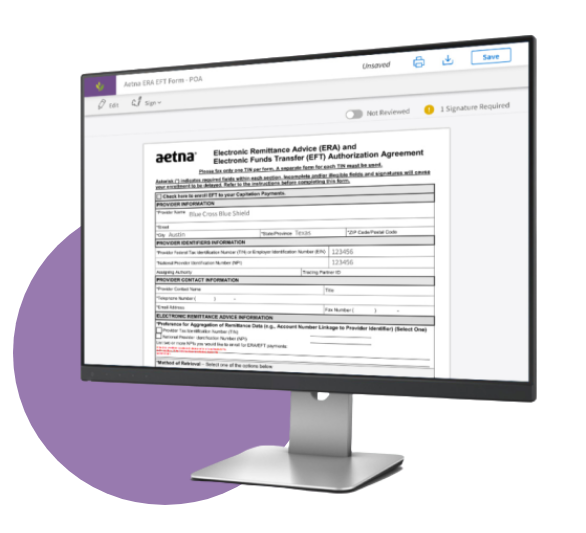
electronic-signature functionality
electronic-signature functionality
electronic-signature functionality
@athenahealth

@athenahealth
RoleExperience Design Intern
Team MemberJeremy Chen (UX), Olivia Liu (PM), Mehdi (Dev), Francys (Dev), Maria (Dev)
ToolsSketch, InVision, iMovie, SurveyMonkey, JIRA
Timeline06/13/2018 - 08/17/2018
Companyathenahealth
What I Have Done
-Identified UX success metrics
-Planned and executed research plan
-Wrote interview screener and script
-Conducted user interviews with 4 participants
-Held affinity diagram workshop
-Designed journey map based on research findings
-Facilitated in-person ideation workshop
-Designed UI flows and Wireframe
-Held design review among 30+ stakeholders
-Designed high-fidelity prototype with Sketch and InVision
-Conducted usability testing with 4 participants including writing moderator script
Challenge In 2018 Summer, I worked for athenahealth as a Experience Design Intern and participated in two scrum team. Currently, athenahealth’s enrollment team and clients are forced to work outside of athenaNet, an athenahealth's Suite Of Cloud-Based Services, to sign payer application forms(e.g. EFT, ERA). On average, this signing process consumes 190 hours over a 90-day period for the Ops team and about 6 days for clients.
Solution How might we implement electronic-signature functionality into the Cloud-Based application to improve the enrollment application form workflows? It provided a service that users can sign forms without leaving athenaNet. However, in reality, there were some trade-off we had to made to meet user needs when business objectives and technical capabilities came in.
What I learned As a embedded Scrum Team UX designer, I have a special role to play in working closely with the Product Owner and Lead Developer to define the product experience. It’s important for UX designer to figure out how I can help Product Owner to answer company’s business problems. I can’t limit myself to follow the UX design process. The most important part is that UXers have to find the best way to answer business problems. Uxers work with PO to uncover user needs and problems through design research and through other types of qualitative or quantitative research, and through analytics.
 Scrum Team
Scrum Team
 Our Scrum team attended athenaConference
Our Scrum team attended athenaConference
athenahealth has a 2018 goal of removing cash flow delays to incomplete enrollment. Today, getting clients to sign enrollment application forms is contributing to enrollments being incomplete at go live because there are unnecessary blockers to capturing the correct client signature. If athenahealth has power of attorney, athenahealth’s enrollment Ops team can edit and sign on client's behalf.
Because of functionality limitations athenaNet has, enrollment ops teams are forced to work outside of athenaNet to sign payer application forms.
This lack of functionality is highly inefficient; per a time study completed by athenahealth’s enrollment Ops team, it took an average of 2.08 minutes to sign a payer form.
Before I can jump into developing a solution, I first have to define the problem our team is solving. This stage of the process requires an in-depth look into the challenges and opportunities facing the business, knowledge of market trends and inspiration, and a rich and nuanced understanding of your users’ needs.
Eliminate the need for paper and unnecessary manual work when processing, signing, and sharing forms & letters.
Incorporate electronic signature functionality into athenaNet to improve the Enrollment application form workflows.
The business impact between before and after implementing electronic-signature functionality for both athenahealth and client's side and competitive analysis between electronic-signature vendor
Adobe Sign will be our electronic-signature vendor.
Our primary users are athenahealth’s enrollment Ops teams. Our secondary users are clients.
Reduce the time of signing per enrollment form to 30 seconds
90% of Enrollment application forms are filled out/signed in athenaNet by athenahealth’s enrollment Ops team, and 0% are filled out/signed outside athenaNet
- The measurement of "Intention To Use" is higher than 4.0 / 5.0.
- The measurement of "Meets The Requirement" is higher than 4.0 / 5.0.
- The measurement of "Perceived Usefulness" is higher than 4.5 / 5.0.
Based on what we got from past research, we knew what the business impact is for both athenahealth and clients if we implement electronic-signature functionality. However, there are still many questions and hypotheses we have to answer before releasing this feature. Because of time constrain, I have to find the proper research methods to answer our hypotheses efficiently.
athenahealth enrollment ops team
Secondary userBusiness clients
We think that Ops teams suffer difficulties when signing the form
- What is the current process of signing form?
- What are the difficulties they have before/during/after signing the form?
- How do Ops users locate the place to sign their signature?
- How do Ops users know which signature type is needed (e.g. wet signature or electronic signature)?
Based on research findings I got from interviews, I synthesized the findings to mental model diagram. It helps us to develop empathy by understanding what goes through people’s minds.
The purpose of this user interview is to answer the hypotheses we have and understand the difficulties athenahealth's enrollment Ops users have when signing enrollment form.
Can you share the experience that you have during signing enrollment form?
What did you do to meet payer's requirement?
What happens if there is a problem with the enrollment form? What will the workflow be?
After conducting user interview, I organized and analysed the feedback through affinity mapping. Below is a journey map that summarizes our findings.
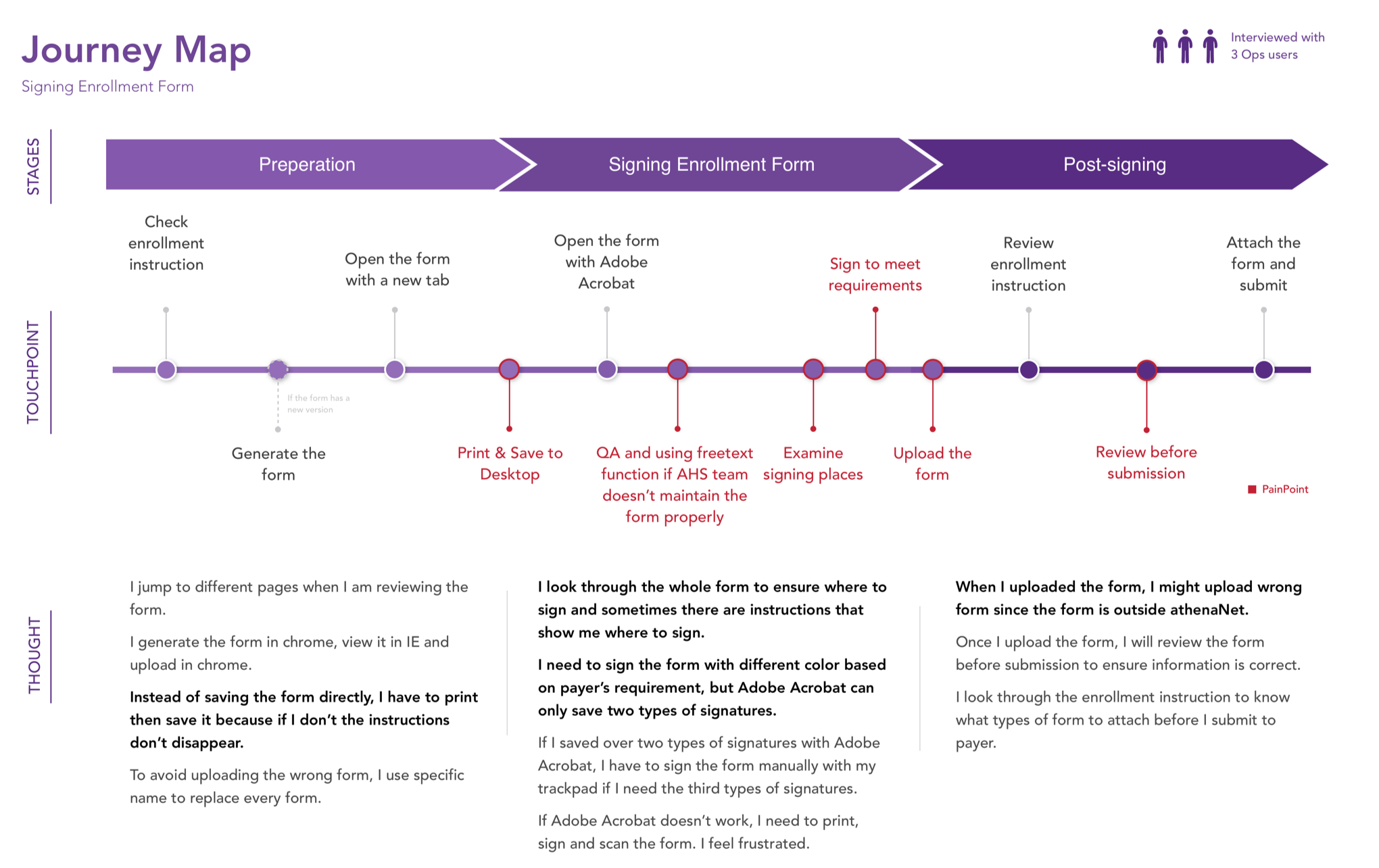 Journey Map
Journey Map
When processing enrollment forms, Ops users are afraid of uploading the wrong form back to athenaNet.
Although the instruction of the form informs Ops users where to sign, Ops users still have a hard time to find the place to sign.
Before submitting the form to payer, Ops users will review the form again and again.
Ops users need to sign the form with different color based on payer’s requirements, but Adobe Acrobat can only save two types of signatures. Ops users have to scan their signature when the payer requires a new color signature.
Based on the feedback I got from user interview, I am more confident and proven that electronic-signature functionality can solve user's needs. Now, I have to bring our “How might we incorporate electronic-signature functionality into athenaNet to improve the enrollment application form workflows ?” questions to your team and create a safe space to encourage fresh and wild ideas. As a good facilitator, I need to stand next to a board, collects and posts individual ideas, enforces the brainstorm rules, and ensures participants remain engaged.
The purpose of this design ideation is to bring our HMW statement to a more concrete concept considering about business, technology and user.
UX Designer
Developers
Product Owner
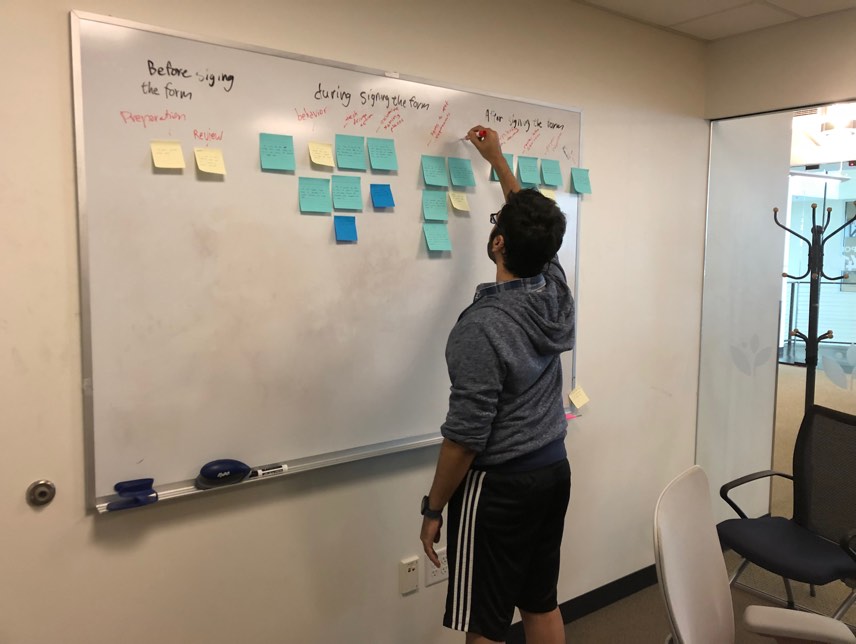 Ideation
Ideation
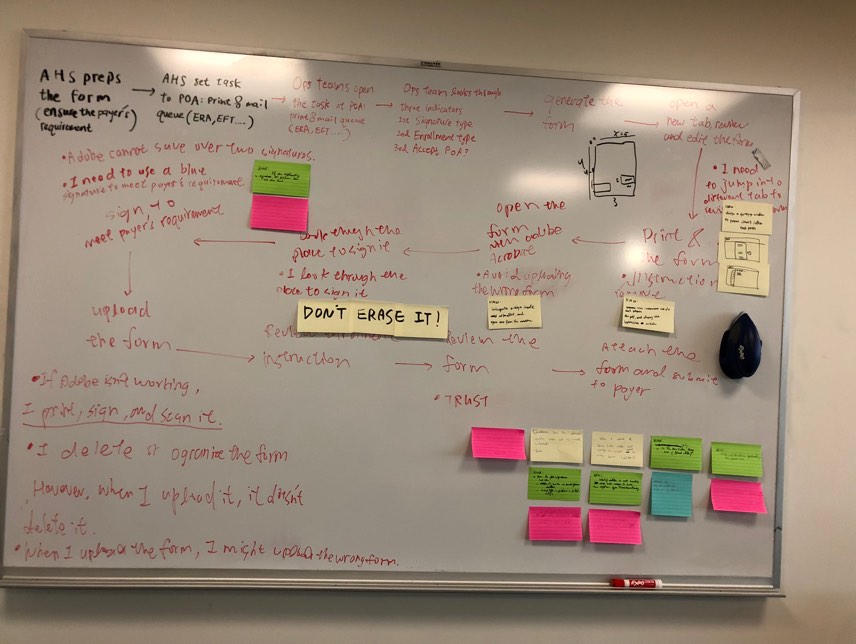 Whiteboarding
Whiteboarding
Paper sketching is different from building an idea ‘properly.’ We know what is required to build something -- so, it can be tempting to build the entire concept. But, paper sketching is about quickly learning and evolving an idea, so it’s better to build just enough to gather feedback of what can or cannot work from tech's point of view and move forward. We sketched several designs to meet user's needs.
The first proposed design is to have the ability of edit and sign the form simultaneously. However, due to developement limitation, I have to make sure that users edit the form before signing.
 Paper Sketching
Paper Sketching
I designed two version of UI flow. One is the ideal flow that provides a vision for the future. The other one is a MVP version that our dev can easily implement to meet limited time frame and see the impact of implementing electronic-signature functionality.
 UI Flow
UI Flow
I used Sketch and InVision to make our first prototype.

As new experience concepts move from abstract to tangible, it’s never too early to prototype and learn, but alignment is necessary to build the right thing. This is a good discussion to have with the team and stakeholders. Ideally, we'll iterate rapidly and increase fidelity as we move towards a pilot.

For this study, I want to measure how ‘usable’ or ‘intuitive’ a website is and how easy it is for users to reach their goals. By using RITE method, it helps us evaluate and identify interface problems and quickly fix them through rapid test-fix-test-fix approach. I designed several scenarios to measure “Intention To Use”, ”Meet the Requirements” and “Perceived Usefulness”. We also calculate the time of completing one form. Those measurements help us identify whether we meet our success metrics.
The purpose of this study is to refine our prototype and identify whether our prototype meet our success metics.
4 Ops Users

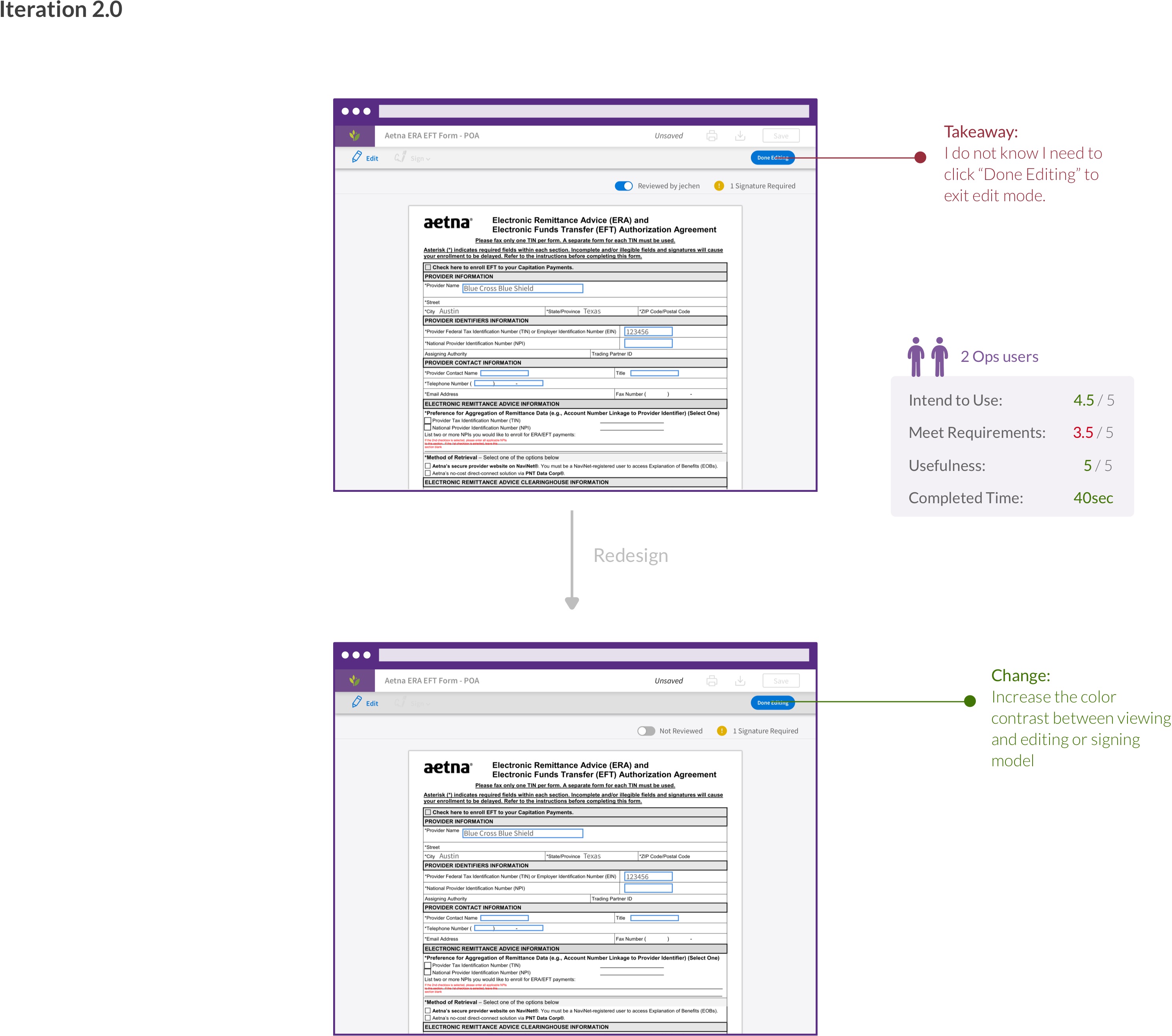
Our release plan divides into two phase, which is alpha/beta and GA phase. After our devs have developed this feature and integrated inside athenaNet, we will release our feature to a small set of target users and evaluate our feature by sending out Standard Feature Perception Instrument Survey. This survey helps us identify whether our developed feature meet our measurements of “Intent to Use”, “Perceived Ease of Use” and “Perceived Usefulness”. We will also analysis our design quality by using heuristic evaluation. Later, if we are confident that this feature is ready for release, we will release it to public.